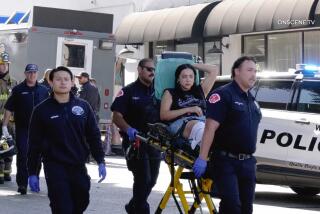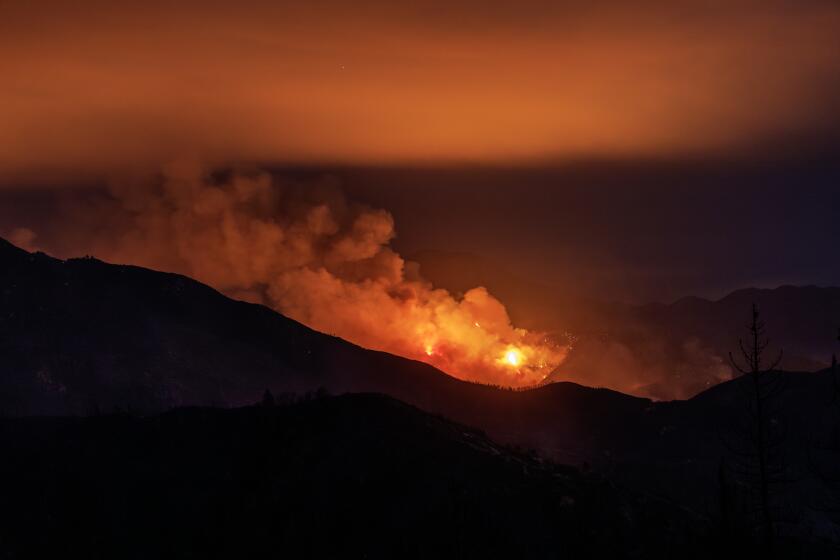‘4-Day Vacation’ Ends in Fairfax Blast Area
Fairfax District businesses that had been closed since Sunday’s gas explosion began to reopen their doors Thursday, and life in the neighborhood struggled back toward normal.
“We had a four-day vacation, that’s all,” said Tom Coulter, who runs a shoe store about a block from the site of the blast that forced evacuation of a four-square-block area for the first part of the week. “Now they say it’s OK to go back--so vacation’s over.”
The decision to allow reopening came at 9 a.m. Thursday, after a conference of Los Angeles city fire officials, geologists and engineers and a review of records from seven gas-monitoring stations in the area.
Fire Department spokesman Alan Masumoto said gas measurements were “zero everywhere,” except for a reading of 6 psi (pounds per square inch) at the vent well drilled in the parking lot of the discount clothing store, where the initial blast occurred.
“So just about everybody can go back,” Masumoto said, “including a couple of places we thought might have to stay closed for a while. . . .”
He was referring to the K mart store and the Gilmore Bank, where monitors had showed high concentrations of gas in the days immediately after the explosion. Masumoto said readings in both locations had dropped to a point where there appeared to be no danger--a development that brought sighs of relief from several elderly residents of the neighborhood.
“Another day or two and I would have been hurting,” said Minnie Seibert, who lives in the Park La Brea towers, not far from the bank, and who was one of the first customers through the doors when they opened at noon. “I keep all my money in the Gilmore Bank, and when it’s closed, I’m out of luck--there aren’t any branches.”
Gilmore Bank President Jack Patterson said the office--located right across West 3rd Street from the blast site--will be open Saturday this week, “to catch up on business and get things running smoothly again.”
His attitude was echoed by other businessmen in the vicinity.
“We’ve been busy since opening this morning,” said Mark Giebel, owner of Mordigan’s Nurseries, the bank’s next-door neighbor. “When we’re not cleaning up debris (from the explosion) we have customers.”
So did most stores in the Town and Country Shopping Center.
Merchants there said trade was “unexpectedly good,” despite rainy weather and publicity surrounding the explosion that demolished the nearby Ross Dress for Less discount clothing store, injuring at least 20 people and touching off dozens of fires fed by underground methane fumes leaking through cracks in the earth.
All those fires were out Thursday, and even the flare stack atop a vent well drilled in the parking lot of the clothing store refused to burn due to lack of gas pressure.
Some regular customers appeared to be making special trips to shop in the area in order to show their support.
“I came,” said housewife Jackie Herst, who was accompanied by her two small daughters, “because I wanted to tell the merchants that I’d be back. I think these people have had a bad time of it.”
“Just wanted to be sure everyone was OK,” said Ben Aguilar, who said he lives in Hollywood but frequently shops in the Fairfax District. “I know some of the people here, and I’d be sorry to see any of them lose out because of something like this.
“I guess they’ll be OK, though. . . .”
Not everyone was able to open immediately, however.
Bob Tusquellas, who runs a fish and seafood stand and a coffee and doughnut shop inside Farmers Market, explained that he would stay closed for another day, because “it takes 12 hours to be ready--if I had ‘fresh fish’ today, I’d be suspicious, if I were you. . . .”
Jerry Alexander, owner of Alexander’s Groceries, said he was having problems too.
“My deliveries,” he explained, “come in at 6 a.m.--but no one was allowed in here until after 9 a.m., so I might as well be closed up again.”
Many other Farmers Market stalls offering fresh or processed foods also remained closed for an additional day while proprietors readied their stocks.
“We’re definitely taking a beating,” Tusquellas said.
But other parts of the market were open, and other merchants in the vicinity expressed thankfulness:
“The Party’s Here,” said a sign at Aytan Stromberg’s greeting card store.
And merchant Max Marantz was philosophical:
“Makes you uneasy, thinking about the gas,” he said. “But life is uneasy--the government is trying to do its best. . . .”
Part of Marantz’s uneasiness centered upon the piles of debris still being cleaned up near his place of business, the unlighted flare stack atop the vent hole and the 10-foot fence going up around the demolished clothing store.
Masumoto said the flare stack will remain a fixture for some time to come and talked of the possibility that monitoring devices might be placed in shops and stores to measure the level of methane gas--and give the alarm when the readings become dangerous.
Nobody knows who would pay for such devices, though, he said, and the program is still under investigation.
Meanwhile, Fire Department officials moved to end a minor controversy over who did--or did not--give early warning on increased levels of methane in the area before Sunday’s explosion.
The increased gas levels were monitored by Southern California Rapid Transit District subcontractors, but Deputy Fire Chief Don Anthony told a meeting of the RTD board of directors that the levels discovered were not high enough to be worth reporting to the Fire Department.
He said the subcontractors did find an “unusually high level” of methane at one of its 80-foot core sampling holes in the Fairfax area, but it was to low to be considered dangerous.
Responding to a question by one board member, he said a leak of that size “wouldn’t even be noticed” if it occurred inside the board’s meeting room.
Later, he agreed that almost any gas presence might be considered a fact worth noting.
But “it’s just like a chicken running down the street before the earthquake,” he said. “You don’t know why until after the quake.”
Times staff writers Nieson Himmel and Eric Malnic contributed to this article.
More to Read
Sign up for Essential California
The most important California stories and recommendations in your inbox every morning.
You may occasionally receive promotional content from the Los Angeles Times.










